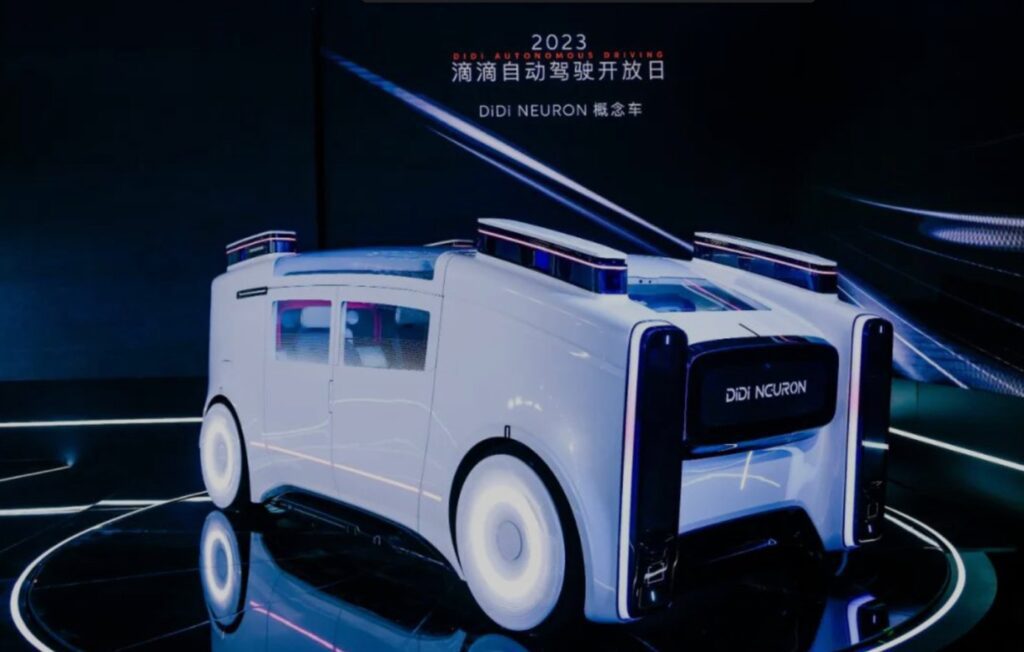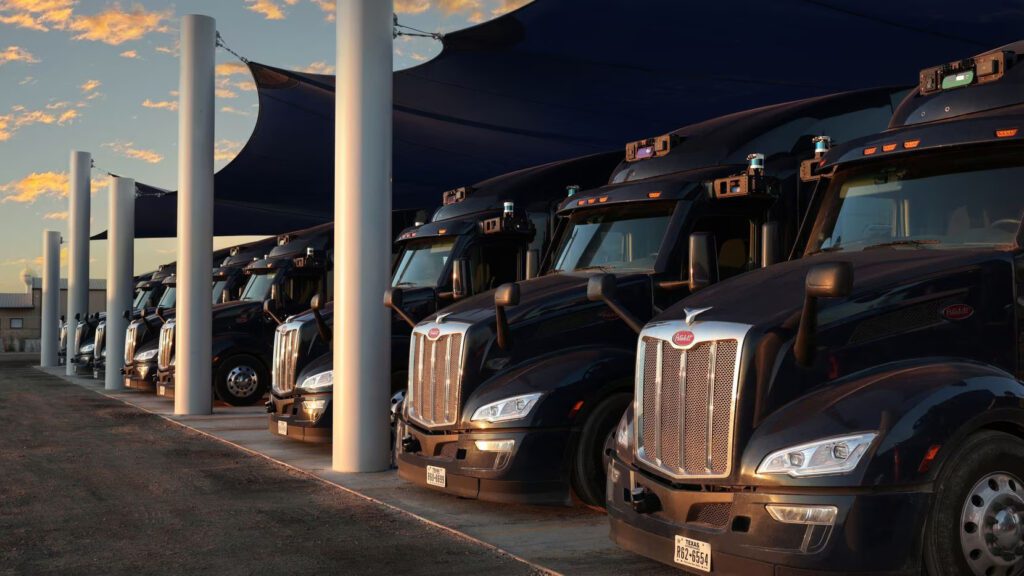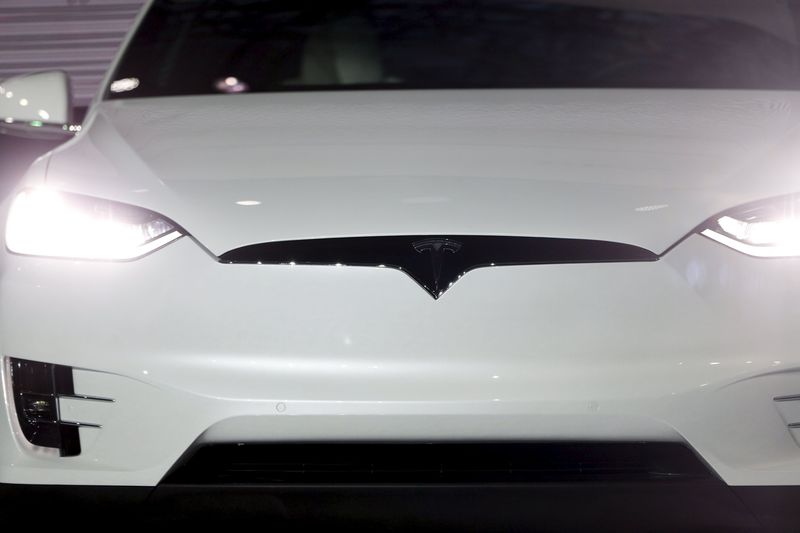
Vueron Newsletter
No. 5
2023.04.18
| Aurora opens first terminal for self-driving trucks near Dallas | ||
| Hesai Releases Ultra-Thin Long-Range Lidar ET25, Providing Behind-the-Windshield ADAS Lidar Solution |
||
1. China’s Didi to dispatch robotaxis 24/7 in 2025, announces trucking service
-
- Didi, the Chinese ride-hailing giant, plans to dispatch self-driving cars (robotaxis) around the clock by 2025.
- Didi will start testing its autonomous ride-hailing service in Shanghai, Beijing, and Shenzhen in the coming months.
- The company announced it would also expand into the trucking business and launch a logistics service in several Chinese cities.
- The new trucking service, called Didi Freight, will initially target short-haul deliveries within 200 km.
- Didi is partnering with several automakers and suppliers to develop autonomous driving technology.
- Didi’s ultimate goal is to build a “one-stop mobility platform” that offers a range of transportation services, from ride-hailing to bike-sharing to self-driving trucks.

Didi’s announcement of its plans to dispatch self-driving cars 24/7 by 2025 shows the company’s ambition to dominate the Chinese ride-hailing and autonomous driving markets. By expanding into the trucking industry, Didi is diversifying its business and potentially creating a new revenue stream. The success of Didi’s new logistics service, Didi Freight, will depend on its ability to compete with established logistics companies in China. The partnership between Didi and several automakers and suppliers is a smart move, as it allows the company to access the latest technology and expertise in autonomous driving. The competition between Didi, Baidu, and Alibaba in the self-driving market will likely intensify in the coming years, as each company seeks to gain a dominant position in the industry.
2. Aurora opens first terminal for self-driving trucks near Dallas
-
- Aurora, a self-driving trucking company, has opened its first autonomous trucking terminal in Texas.
- The terminal is located near Dallas and will serve as a hub for the company’s autonomous trucking operations.
- The terminal includes offices, a maintenance center, and a staging area for autonomous trucks.
- Aurora plans to use the terminal to test and refine its self-driving trucks before deploying them on the road.
- The company has already secured contracts with several shippers and plans to begin hauling freight later this year.
- Aurora is focused on developing self-driving technology that can operate on highways, allowing drivers to rest while the truck drives itself.
- The company is also partnering with truck manufacturers to develop autonomous trucks that can be integrated with its software.

Aurora’s opening of the autonomous trucking terminal in Texas is a significant milestone for the company and the self-driving trucking industry. The terminal will allow Aurora to test and refine its self-driving technology in a real-world setting, which is crucial for the success of its autonomous trucking operations. By partnering with truck manufacturers, Aurora is positioning itself as a key player in the development of autonomous trucks. The ability for drivers to rest while the truck drives itself has the potential to revolutionize the trucking industry, as it could make long-haul trucking more efficient and cost-effective. The success of Aurora’s autonomous trucking operations will depend on the company’s ability to secure contracts with shippers and demonstrate the safety and reliability of its self-driving trucks. The opening of the autonomous trucking terminal in Texas is a sign that the self-driving trucking industry is rapidly advancing and could be a reality sooner than many people expect.
3. Luminar Sets Up New LiDAR Plant In Same Neighborhood As Tesla’s Latest Gigafactory
-
- Luminar, a company that specializes in LiDAR technology for autonomous vehicles, has opened a new manufacturing plant in Texas, near Tesla’s Gigafactory.
- The new plant is capable of producing LiDAR sensors for autonomous vehicles at a large scale.
- Luminar’s LiDAR technology is used by several automakers, including Volvo and Toyota, for their autonomous vehicle projects.
- The new plant will allow Luminar to meet the increasing demand for LiDAR sensors in the autonomous vehicle market.
- Luminar’s LiDAR technology has a longer range and higher resolution than other LiDAR sensors on the market. The company is also working on a new version of its LiDAR sensor that is smaller and cheaper than previous versions.

Luminar’s decision to open a new manufacturing plant in Texas, near Tesla’s Gigafactory, is a strategic move that positions the company at the center of the growing autonomous vehicle market. The demand for LiDAR sensors is expected to increase as more automakers invest in autonomous driving technology, and Luminar’s new plant will allow the company to meet this demand. The development of a smaller and cheaper version of Luminar’s LiDAR sensor is a positive step towards making autonomous driving technology more affordable and accessible to a wider range of consumers. The success of Luminar’s autonomous vehicle technology will depend on its ability to establish partnerships with automakers and demonstrate the safety and reliability of its LiDAR sensors. The growth of the autonomous vehicle market presents significant opportunities for companies like Luminar, and the opening of its new manufacturing plant is a sign that the industry is rapidly advancing.
4. Hesai Releases Ultra-Thin Long-Range Lidar ET25, Providing Behind-the-Windshield ADAS Lidar Solution
-
- Hesai, a Chinese LiDAR sensor manufacturer, has released a new ultra-thin long-range LiDAR sensor, the ET25, that provides behind-the-windshield Advanced Driver Assistance Systems (ADAS) LiDAR solution.
- The ET25 sensor is only 7.5mm thick and can be installed behind the windshield, providing a more streamlined and aesthetically pleasing solution compared to traditional LiDAR sensors that are mounted on the exterior of the vehicle.
- The sensor has a range of up to 200 meters and can detect objects with high accuracy, even in challenging weather conditions.
- The ET25 sensor is designed to be integrated with existing ADAS systems and can provide additional data for tasks such as lane departure warnings, forward collision warnings, and adaptive cruise control. The sensor is also compatible with autonomous driving systems and can be used for mapping and localization.
- The release of the ET25 sensor is expected to enhance Hesai’s position in the global LiDAR sensor market.

Hesai’s release of the ET25 sensor is a significant step towards providing a more integrated and streamlined solution for ADAS systems. By allowing the sensor to be installed behind the windshield, Hesai is addressing a key concern for consumers and automakers regarding the aesthetic and practical implications of traditional LiDAR sensors. The sensor’s long range and high accuracy make it a suitable solution for a wide range of ADAS and autonomous driving applications. The success of Hesai’s ET25 sensor will depend on the company’s ability to establish partnerships with automakers and demonstrate the safety and reliability of its LiDAR sensors. The growth of the ADAS and autonomous driving market presents significant opportunities for LiDAR sensor manufacturers like Hesai, and the release of the ET25 sensor is a sign that the industry is rapidly advancing.
5. Waymo’s vehicles are confused by San Francisco’s fog
-
- Self-driving cars developed by Waymo struggled to navigate through dense fog in San Francisco.
- Waymo vehicles encountered difficulties in identifying and responding to obstacles, including pedestrians, in conditions of poor visibility.
- The company has been testing its autonomous vehicles in San Francisco for several years as part of its efforts to develop self-driving technology for commercial use.
- The incident highlights the limitations of current self-driving technology and the challenges that companies such as Waymo face in developing fully autonomous vehicles that can operate safely in all conditions.
- Waymo has not commented publicly on the incident, but it is likely that the company will continue to refine its technology and algorithms to improve the performance of its self-driving cars in adverse weather conditions.

The recent incident involving Waymo’s self-driving cars highlights the challenges and limitations of current self-driving technology. While self-driving cars have the potential to revolutionize the way we travel and reduce the number of accidents caused by human error, their ability to operate safely in adverse weather conditions remains a major hurdle. As companies such as Waymo continue to refine their technology and algorithms, they will need to consider how their self-driving cars will operate in a range of weather conditions, including fog, rain, and snow. Despite the challenges, the development of self-driving technology is likely to continue, driven by the potential economic and environmental benefits that autonomous vehicles could provide.
*Contents above are the opinion of ChatGPT, not an individual nor company

